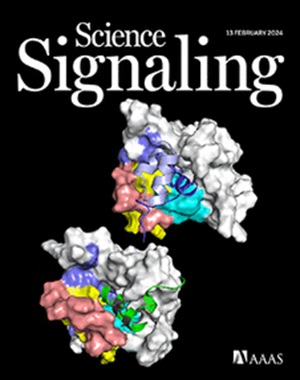TIM3 is a context-dependent coregulator of cytotoxic T cell function
IF 6.6
1区 生物学
Q1 BIOCHEMISTRY & MOLECULAR BIOLOGY
引用次数: 0
Abstract
TIM3 is a coregulatory receptor that is highly abundant on multiple immune cell types, including T cells in response to prolonged exposure to antigen, and it marks functionally suppressed cytotoxic T lymphocytes (CTLs) in the tumor microenvironment. TIM3 exhibits inhibitory function in vivo but paradoxically has costimulatory T cell signaling capability in vitro. Here, we found that TIM3 directly inhibited the function of murine and human CTLs in direct interaction with target tumor cell spheroids. TIM3 regulated the ability of suppressed CTLs to polarize their actin cytoskeleton as a required step in cytolysis. Whereas the expression of the proposed TIM3 ligands CEACAM1 and galectin 9 in trans on target tumor cells enhanced TIM3 function, expression of CEACAM1 in cis on CTLs had the opposite effect. TIM3 functioned as an inhibitory receptor on spheroid-suppressed CTLs but not on active CTLs in a two-dimensional tissue culture model. Together, these data suggest that TIM3 enhances T cell function, serving as either a coinhibitory or costimulatory receptor depending on the functional context of the T cell on which it is expressed.
TIM3是细胞毒性T细胞功能的上下文依赖的共调节因子
TIM3是一种协同调节受体,在多种免疫细胞类型中高度丰富,包括对抗原长期暴露的T细胞,它标志着肿瘤微环境中功能抑制的细胞毒性T淋巴细胞(ctl)。TIM3在体内表现出抑制功能,但矛盾的是,在体外具有共刺激T细胞信号传导能力。在这里,我们发现TIM3直接抑制小鼠和人类ctl与靶肿瘤细胞球体直接相互作用的功能。TIM3调节抑制的ctl使其肌动蛋白细胞骨架极化的能力,这是细胞溶解的必要步骤。在靶肿瘤细胞上反式表达TIM3配体CEACAM1和凝集素9可增强TIM3的功能,而在ctl上顺式表达CEACAM1则具有相反的作用。在二维组织培养模型中,TIM3作为球形抑制型ctl的抑制受体,而不作为活性ctl的抑制受体。综上所述,这些数据表明TIM3增强T细胞功能,根据其表达的T细胞的功能背景,作为共抑制或共刺激受体。
本文章由计算机程序翻译,如有差异,请以英文原文为准。
求助全文
约1分钟内获得全文
求助全文
来源期刊

Science Signaling
BIOCHEMISTRY & MOLECULAR BIOLOGY-CELL BIOLOGY
CiteScore
9.50
自引率
0.00%
发文量
148
审稿时长
3-8 weeks
期刊介绍:
"Science Signaling" is a reputable, peer-reviewed journal dedicated to the exploration of cell communication mechanisms, offering a comprehensive view of the intricate processes that govern cellular regulation. This journal, published weekly online by the American Association for the Advancement of Science (AAAS), is a go-to resource for the latest research in cell signaling and its various facets.
The journal's scope encompasses a broad range of topics, including the study of signaling networks, synthetic biology, systems biology, and the application of these findings in drug discovery. It also delves into the computational and modeling aspects of regulatory pathways, providing insights into how cells communicate and respond to their environment.
In addition to publishing full-length articles that report on groundbreaking research, "Science Signaling" also features reviews that synthesize current knowledge in the field, focus articles that highlight specific areas of interest, and editor-written highlights that draw attention to particularly significant studies. This mix of content ensures that the journal serves as a valuable resource for both researchers and professionals looking to stay abreast of the latest advancements in cell communication science.
 求助内容:
求助内容: 应助结果提醒方式:
应助结果提醒方式:


